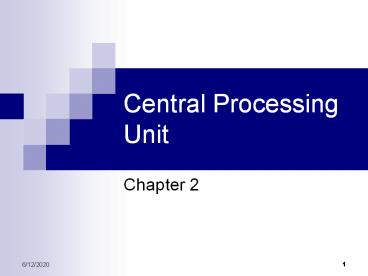Central Processing Unit - PowerPoint PPT Presentation
Title:
Central Processing Unit
Description:
RISC vs. CISC. RISC (reduced instruction set computer) Complementary set of first eight CISC principles. Simple single cycle instructions ... – PowerPoint PPT presentation
Number of Views:74
Avg rating:3.0/5.0
Title: Central Processing Unit
1
Central Processing Unit
- Chapter 2
2
Topics
- Central processing unit
- Internal architecture
- Fetch and execute cycles
- Microcontrollers
- Instruction formats
- Core instructions
- Addressing modes
- RISC vs CISC
- Memory
- Memory Access
- Memory Technologies
- Memory hierarchy
- Memory Organization
- Input/Output
- Programmed IO
- Direct memory access (DMA)
- Memory mapped IO
- Interrupts
- Programmable Interrupt controller
3
Internal Architecture of a CPU (Z80)
4
Fetch and Execute Cycles
- Macro instructions are fetched from memory and
executed. - Fetch and execute cycles simple overlap.
5
Microcontroller approach (fig.2.7)
- Microcontroller is a internal processor that is
programmable via microinstructions. - This approach is highly relevant to real-time
systems and devices since each macro instruction
is mapped into a set of microinstructions that
can be directly executed with decoding etc. - Fine grained instructions are in micro memory and
are wider than macro instructions. - These microinstructions directly control the
logic gates of the microcontroller. - Microcontroller can take direct input from
devices and can signal directly to devices. - High level language support is available for
software development using microcontrollers. - Examples Intel 8051, 8748, MCS 51/251
- See http//www.intel.com/design/embcontrol/index.h
tm
6
Instruction formats
- 1, 0 address forms (implicit operands,
destination) example pop - 2-address forms arithmetic operations
- 3-address forms
- Core instructions
- Horizontal bit operations XOR, AND, NOT
- Vertical bit operations rotate right, rotate
left - Control trap, cli, epi, dpi, halt
- Data movement store/load
- Math/special processing add, sub, bts (lock)
7
Addressing Modes
- Immediate
- Direct memory
- Indirect memory
- Register
- Auto-increment, auto-decrement
8
RISC vs CISC
- CISC (complex instruction set computer)
- Complex instructions multiple cycles
- Any instruction can ref memory
- No instructions are pipelined
- Micro-program for native instruction
- Variable format instructions
- Multiple instructions and addressing mode
- Single set of registers
- Complexity is in the micro-program and hardware
9
RISC vs. CISC
- RISC (reduced instruction set computer)
- Complementary set of first eight CISC principles
- Simple single cycle instructions
- Load/store only can reference memory
- Highly pipelined
- Instructions directly executed by hardware
- Fixed-format instructions
- Few instructions and addressing modes
- Large multiple set of registers
- Complexity handled by the compiler and software
- Advantage for real-time system average
instruction execution time is lower than cisc - Disadvantage associated with cache and elaborate
multistage pipeline, while this improves
performance for average case, pathological
(extreme) situations may not be handled
satisfactorily. Many real-time systems typically
encounter extreme conditions.
10
Memory
- Memory access time interval between when a datum
is requested and when it is available to the CPU. - This can have profound effect on real-time
performance. - Real access time is decided by the physical
characteristic of the memory chosen. - Effective access time depends on type, memory
technology, memory layout (ex memory
interleaving), and buffering etc.
11
Memory Access
- Typical microprocessor read cycle embodies the
handshaking between the processor and main memory
store. - CPU places address on address bus and allows
signal to settle. - Then it places appropriate data on the data bus.
- CPU asserts ALE (Address Latch enable)
- CPU sends out WR signal
- Memory device is selected and the data is written
to the addressed location - All are synchronized to the system clock.































